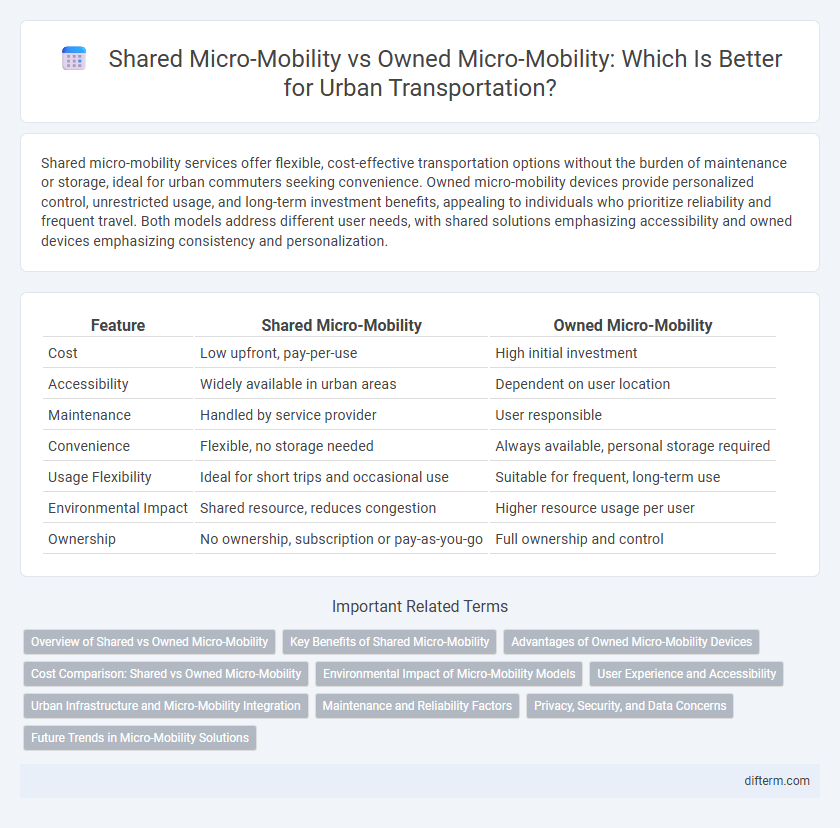Shared micro-mobility services offer flexible, cost-effective transportation options without the burden of maintenance or storage, ideal for urban commuters seeking convenience. Owned micro-mobility devices provide personalized control, unrestricted usage, and long-term investment benefits, appealing to individuals who prioritize reliability and frequent travel. Both models address different user needs, with shared solutions emphasizing accessibility and owned devices emphasizing consistency and personalization.
Table of Comparison
| Feature | Shared Micro-Mobility | Owned Micro-Mobility |
|---|---|---|
| Cost | Low upfront, pay-per-use | High initial investment |
| Accessibility | Widely available in urban areas | Dependent on user location |
| Maintenance | Handled by service provider | User responsible |
| Convenience | Flexible, no storage needed | Always available, personal storage required |
| Usage Flexibility | Ideal for short trips and occasional use | Suitable for frequent, long-term use |
| Environmental Impact | Shared resource, reduces congestion | Higher resource usage per user |
| Ownership | No ownership, subscription or pay-as-you-go | Full ownership and control |
Overview of Shared vs Owned Micro-Mobility
Shared micro-mobility offers flexible access to electric scooters and bicycles without the responsibilities of maintenance or storage, making it ideal for urban commuters seeking convenience. Owned micro-mobility vehicles provide consistent availability and personalized customization but require upfront investment and ongoing upkeep. Urban infrastructure and user lifestyle preferences heavily influence the choice between shared and owned micro-mobility solutions.
Key Benefits of Shared Micro-Mobility
Shared micro-mobility offers significant advantages including cost-efficiency, reduced urban congestion, and environmental sustainability through lower carbon emissions compared to owned micro-mobility. It enhances accessibility by providing on-demand, flexible transportation options without the need for personal vehicle maintenance or storage. Major urban centers report increased public transit integration and decreased private car usage, promoting smarter, eco-friendly mobility ecosystems.
Advantages of Owned Micro-Mobility Devices
Owned micro-mobility devices offer greater convenience and reliability by providing immediate access without the need to locate and unlock shared units. They ensure personalized maintenance and customization, enhancing safety and user comfort tailored to individual preferences. Ownership also supports consistent availability, reducing dependency on fluctuating shared fleet distributions and usage restrictions.
Cost Comparison: Shared vs Owned Micro-Mobility
Shared micro-mobility offers lower upfront costs and eliminates expenses related to maintenance, storage, and repairs compared to owned micro-mobility devices like e-scooters and bikes. While owned micro-mobility entails significant initial investment and ongoing costs, shared services provide flexible, pay-as-you-go pricing models that enhance affordability for urban commuters. Cost efficiency in shared micro-mobility supports sustainable urban transportation by reducing financial barriers for short-distance travel.
Environmental Impact of Micro-Mobility Models
Shared micro-mobility reduces overall carbon emissions by maximizing vehicle utilization and minimizing the need for private car trips, leading to lower environmental footprints compared to owned micro-mobility. Studies show shared e-scooters and bikes cut CO2 emissions by up to 30% per trip versus individual vehicle ownership. However, challenges like battery disposal and scooter lifespan affect the true environmental benefits of shared models relative to privately owned micro-mobility devices.
User Experience and Accessibility
Shared micro-mobility offers flexible, on-demand access to e-scooters and bikes, reducing the need for personal storage and maintenance, which enhances urban mobility convenience. Owned micro-mobility devices provide consistent availability and personalized settings, improving user familiarity and control but may require higher upfront costs and parking space. Accessibility in shared services is often bolstered by widespread distribution and app-based booking systems, while ownership guarantees immediate device access but can limit usage to specific geographic locations.
Urban Infrastructure and Micro-Mobility Integration
Shared micro-mobility systems optimize urban infrastructure by reducing the need for extensive parking spaces and promoting efficient use of public roads through dynamic vehicle distribution and real-time data analytics. Owned micro-mobility often requires dedicated parking and charging facilities, imposing higher spatial demands and potentially disrupting pedestrian flows in dense urban environments. Effective integration prioritizes adaptable infrastructure, such as smart bike lanes and modular charging stations, to support both shared and owned micro-mobility while enhancing connectivity and reducing congestion.
Maintenance and Reliability Factors
Shared micro-mobility services rely on routine centralized maintenance to ensure vehicle reliability across diverse urban settings, minimizing downtime and enhancing user trust. Owned micro-mobility devices demand individualized upkeep, which can lead to inconsistent maintenance quality and variable performance depending on user diligence. Fleet operators utilize real-time data analytics and predictive maintenance to optimize shared vehicle uptime, a capability rarely feasible for individual owners.
Privacy, Security, and Data Concerns
Shared micro-mobility services raise significant privacy and security issues due to the centralized collection and potential misuse of user location and travel data. Owned micro-mobility devices offer greater control over personal data, reducing exposure to third-party data breaches and unauthorized tracking. Users demand enhanced data encryption, stringent access controls, and transparent privacy policies to mitigate risks associated with shared micro-mobility platforms.
Future Trends in Micro-Mobility Solutions
Shared micro-mobility solutions are projected to expand rapidly, driven by urban population growth and increasing demand for sustainable transport options. Advances in electric vehicle technology and AI-powered fleet management systems will enhance efficiency and user experience for shared micro-mobility services. Owned micro-mobility devices will see innovations in battery life, portability, and customization, catering to personal convenience and long-term usage trends.
Shared micro-mobility vs owned micro-mobility Infographic

 difterm.com
difterm.com